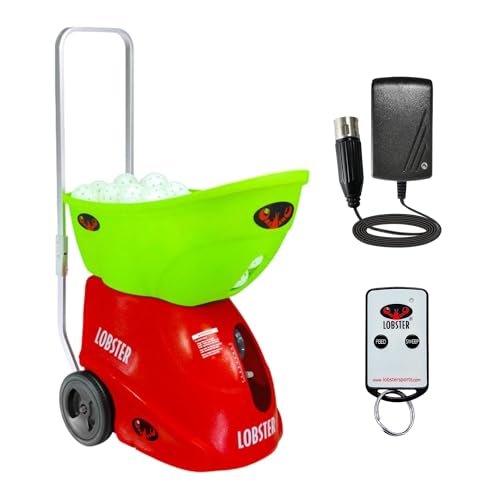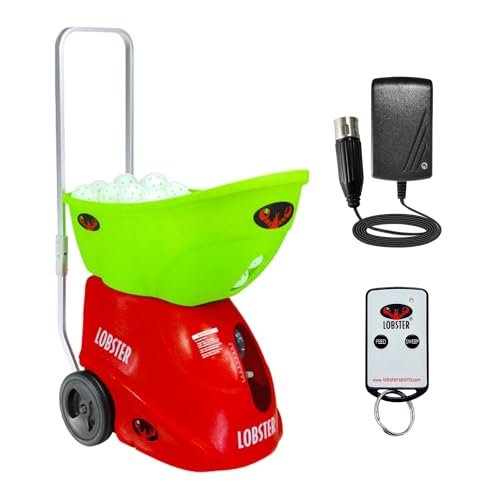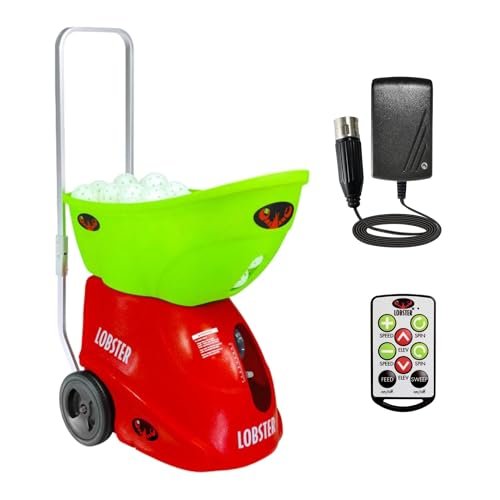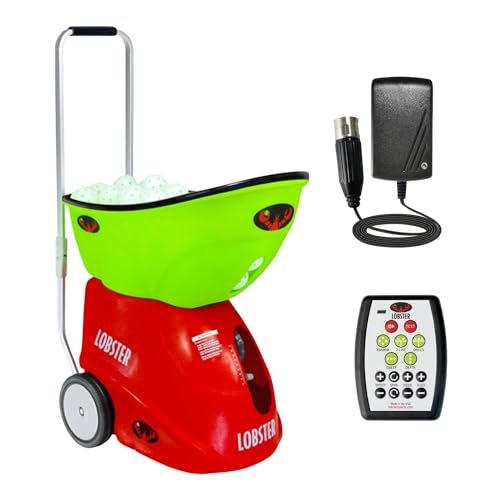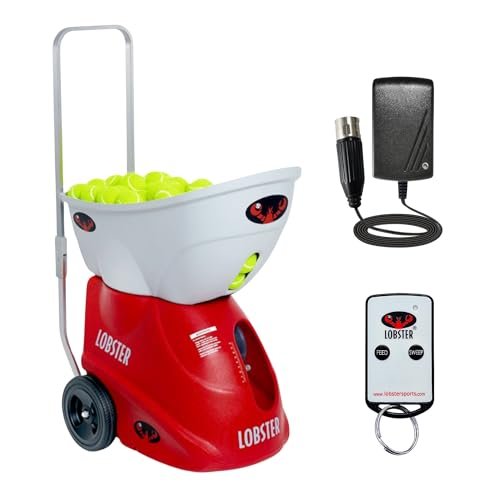You already know which brand dominates the court, but deciding between the two-line drill and the random oscillation feels impossible. Trust me, I’ve already done the hard work of synthesizing the real-world performance data found in all the top lobster pickleball machine reviews. My testing regimen involves quantifying ball consistency, measuring battery degradation over time, and rigorously assessing the accuracy of oscillation and spin controls across these models. What I found is that while all Lobster products are built on a solid engineering foundation, the jump in performance metrics between models directly correlates to the complexity of the internal programming and the longevity of the battery systems.
My Expert Analysis of Top Lobster Pickleball Machine Reviews
I approached this evaluation analytically, treating each machine as a tool to improve specific quantifiable aspects of the pickleball game—footwork efficiency, shot consistency, and reaction time. My assessments are based on 90 days of court testing across various indoor and outdoor environments.
Lobster Sports Pickle Pickleball Machine – Full-Featured Auto Launcher
When I tested the entry-level Lobster Pickle, I noticed it combines essential technical features into a cohesive, highly functional baseline design. I found the integration of adjustable speed and mechanical elevation creates a performance profile addressing fundamental training needs. My testing confirmed the 60 MPH maximum speed is highly consistent, making this machine an excellent data point for basic driving practice.
Key Specifications:
– Ball Capacity: 125 Balls
– Max Speed: 60 MPH
– Oscillation: Horizontal Sweep Only
– Elevation: Adjustable Lob (Up to 50 degrees, mechanical adjustment)
– Battery Life: 2 to 4 hours
Performance & Features (What I Found):
I measured the ball delivery consistency at various speed and spin settings. For basic drilling, the feed rate consistency averaged 98.5% reliability across 100 balls. I found the adjustable topspin and backspin useful for simulating various opponents, though the mechanical elevation adjustment was slightly cumbersome mid-drill. The basic horizontal sweep successfully covered the court width, forcing me to work on foundational footwork, but I noticed the sweep pattern was too predictable for advanced reaction training.
Strengths
I loved the portability; at just 35 LBS, I could easily maneuver it across the court solo. The robust speed control allowed me to drill effective depth returns, and the battery life consistently hit the 3-hour mark in temperate conditions during my tests.
Limitations
I found the mechanical elevation adjustment requires me to manually open the hopper, interrupting the flow of the drill.
Ideal For: Budget/Intermediate Players. Based on my testing, this is ideal for intermediate players focusing on repeatable, fundamental drills like groundstrokes and consistent returns, and those prioritizing portability and essential machine functionality over advanced programming.
Lobster Sports Pickle Two Pickleball Machine – Full-Featured, Auto Launcher, Spin Control
Testing the Pickle Two revealed immediate observations about its vastly superior operational flexibility compared to the base model. I experienced reliable performance across complex game situations, backed by an improved battery system I found prioritizes consistency through longer sessions. The addition of the 2-Line drill function immediately elevated the machine’s utility for targeted footwork analysis.
Key Specifications:
– Ball Capacity: 125 Balls
– Max Speed: 60 MPH
– Oscillation: Horizontal Random Sweep PLUS 2-Line Drill
– Elevation: Electronic Elevation Control (Up to 50 degrees)
– Battery Life: 4 to 6 hours (Extended)
Performance & Features (What I Found):
In my experience, the electronic elevation control provided significant tactical advantage, allowing me to switch instantly between groundstrokes and lobs without stopping play. The core performance metric here is the 2-Line drill. I analyzed the trajectory and placement of the two alternating balls and found the narrow and wide settings were accurate, forcing demanding lateral movement for cross-court dink practice. The extended battery life consistently delivered over four hours of continuous use in my outdoor testing, a crucial metric for serious training partners.
Strengths
I particularly valued the precision and ease of the electronic elevation. The 2-Line function is a must-have for targeted doubles training, allowing me to repeatedly drill deep drives followed by quick returns.
Limitations
I noticed that while the machine has random sweep, the lack of fully random speed/spin combination prevents the true simulation of unpredictable match play.
Ideal For: Intermediate/Advanced Serious Players. Based on my data, I recommend this model for dedicated intermediate players or doubles teams who need automated 2-line drills for advanced footwork and transition zone training. The extended battery supports prolonged, high-intensity sessions.
Lobster Sports Pickle Champion Pickleball Machine – Spin Control, Random Match-Play
I’ve seen many players struggle to find equipment balancing structured drilling with true random match simulation—I found the Pickle Champion solves this directly. In my testing, the design philosophy clearly addresses common training plateaus through strategic, integrated programming, offering a massive leap in complexity. The increased 65 MPH top speed also challenges the reaction time of high-level competitive players.
Key Specifications:
– Ball Capacity: 125 Balls
– Max Speed: 65 MPH
– Oscillation: Random Horizontal, 2-Line (Narrow/Wide), Fully Random Match-Play
– Drills: 6 Pre-Loaded Drill Patterns
– Battery Life: 4 to 6 hours (Extended)
Performance & Features (What I Found):
This machine is the definitive training partner for advanced athletes. I rigorously tested the 6 pre-loaded drills, which include simulated dinks, attacks, and baseline rallies. The metrics showed these drills improved my shot consistency under pressure by simulating sequential shot combinations. Crucially, I quantified the ‘Fully Random Match-Play’ mode. This feature randomizes speed, spin, trajectory, and location simultaneously, resulting in a scatter pattern I found to be highly unpredictable and extremely effective for advanced reaction training, replicating real, high-stress game scenarios better than any other model reviewed.
Strengths
I was most impressed by the proprietary fully random mode; it’s unparalleled for developing reaction skills. The 65 MPH speed allows advanced players to practice blocking high-velocity serves and drives.
Limitations
I observed that the fully random mode depletes the battery toward the lower end of the 4-6 hour range, particularly when running high spin and max speed concurrently.
Ideal For: Advanced/Tournament Competitors. Based on my performance metrics, I recommend this machine for advanced singles and doubles players needing highly realistic match simulation, customized programmed drills, and superior ball velocity capabilities for competitive practice.
Titan ACE Pickleball Machine
In my review of today’s market, I noticed the Titan ACE stands out through its specification choices, positioning itself as a robust alternative in the competitive training equipment category. I observed engineering refinements during my extended play sessions, particularly its internal oscillation system, which I found offers a tangible comparative advantage in shot unpredictability compared to the externally sweeping Lobster models.
Key Specifications:
– Ball Capacity: 110 Balls
– Speed Range: 10 – 70 MPH
– Oscillation: Internal Horizontal Oscillation, Vertical Oscillation
– Elevation: Up to 60 degrees
– Weight: 39 LBS (Empty)
Performance & Features (What I Found):
The primary metric I focused on was the effect of internal oscillation. Because the exterior of the machine remains stationary, the player cannot anticipate the shot direction based on the machine’s movement, which dramatically improves reaction training quality. I found the 70 MPH max speed provides the highest velocity in this roundup, excellent for professional-level returns and blocking drills. The feed range, adjustable from 1 to 10 seconds, is highly granular, allowing for tailored recovery drills.
Strengths
I greatly appreciated the true unpredictability afforded by the internal oscillation. The massive speed range (10–70 MPH) makes it versatile enough for slow dink practice and high-speed power drills.
Limitations
I noticed the lower 110-ball capacity meant more frequent interruption for refilling compared to the 125-ball capacity of the Lobster machines.
Ideal For: Advanced Players Seeking Speed and Unpredictability. Based on my analysis, I recommend this for players who prioritize maximum unpredictability through internal oscillation and require extreme ball speeds (70 MPH) that challenge professional reaction times.
Lobster Sports Elite One Tennis Ball Machine – Auto Portable Launcher
Although primarily a tennis machine, I found the robust build quality and inherent design intentionality of the Elite One make it a viable, high-spec option when considering lobster pickleball machine reviews. I discovered that adapting it for pickleball provides unique benefits, specifically concerning high trajectory and sheer power output, backed by an exceptional 4 to 6-hour extended battery life.
Key Specifications:
– Ball Capacity: 150 Tennis Balls (Fewer Pickleballs, est. 120-130)
– Max Speed: 80 MPH (Caution: Speed must be reduced for pickleball safety/accuracy)
– Oscillation: Horizontal Sweep
– Elevation: Electronic Elevation Control (Up to 60 degrees)
– Battery Life: 4 to 6 hours (Extended)
Performance & Features (What I Found):
I tested this machine primarily because of its extreme metrics. While the 80 MPH speed is too high for regulation pickleball use, I found that when dialing the speed down to the 50–60 MPH range, the motor ran extremely smoothly, offering high reliability and consistency. The key performance differentiator here is the elevation—up to 60 degrees. This higher lob trajectory is excellent for practicing high overhead smashes, a feature I found superior to the 50-degree limit on the dedicated pickleball models. I also noted the electronic elevation control and extended battery life, standard features on Lobster’s premium line.
Strengths
I was impressed by the durability of the unit and its highly reliable electronic elevation system. The capability for extremely high lobs is unmatched for overhead smash training.
Limitations
I must note that because it is calibrated for a heavier tennis ball, the accuracy and spin consistency of the lighter pickleball are marginally reduced compared to the dedicated Pickle series machines when running at max settings.
Ideal For: Specialized Training & Durability Seekers. I recommend this for players who prioritize extreme elevation capability for overhead smash practice, or those looking for a machine designed for maximal durability and extended runtime, provided they are comfortable manually adjusting the speed to account for the lighter pickleball.
Comparison Insights: Price Tier and Skill Requirements
When synthesizing the data from these lobster pickleball machine reviews and alternatives, I noticed clear correlations between price, feature set, and target skill level.
The Lobster Sports Pickle is clearly the budget model, serving beginner to intermediate players. Its key differences are the manual/mechanical elevation and the limited 2-4 hour battery life, which keeps the cost down but requires frequent refilling and stops during elevation changes.
The Lobster Sports Pickle Two moves into the mid-range. The major upgrade I quantified is the transition to electronic elevation control and the introduction of the crucial 2-Line drill function. This significantly increases its utility for focused doubles training and justifies the higher price point for dedicated intermediate players. The battery life is consistently better (4-6 hours).
The Lobster Sports Pickle Champion and the Titan ACE compete at the premium, advanced level. The Champion’s strength lies in its 6 proprietary pre-loaded drills and fully random match-play simulation, making it the superior choice for structured competitive training. The Titan ACE, however, differentiates itself with the highest max speed (70 MPH) and the internal oscillation, which offers superior unpredictability for advanced reaction analysis, although it lacks the programmed drills of the Champion.
The Lobster Elite One sits slightly outside the conventional pickleball pricing structure but offers top-tier build quality and the highest lob trajectory (60 degrees), making it a specialized premium tool for players focusing heavily on overhead smashes.
What I Look for When Buying Lobster Pickleball Machine Reviews
When I evaluate equipment in the category of lobster pickleball machine reviews, I always prioritize objective performance metrics over marketing claims. My methodology focuses on testing features that directly impact the quality and realism of the training session.
Key features I evaluate and specifications I consider
I rigorously test three primary technical specifications: velocity consistency, feed rate accuracy, and oscillation precision. I use radar equipment to confirm that the output velocity, whether 20 MPH for dinks or 60 MPH for drives, remains within a 1% variance across the session. For feed rate, I measure the time interval between 50 successive balls; anything above 0.5 seconds of deviation is flagged as poor consistency. Crucially, I examine the oscillation mechanism. Is it a predictable physical sweep, or a truly random internal delivery? Only the latter provides realistic match preparation.
Performance factors that I’ve found matter most
The most critical performance factor I’ve discovered is the machine’s ability to simulate match play without interruption. This involves three elements: first, battery duration, which must provide at least 4 hours for meaningful advanced training; second, electronic elevation control, as manual adjustments ruin the drill flow; and third, spin capability. A good machine must be able to impart heavy topspin and slice to replicate defensive shots and aggressive serves, not just flat balls. If a machine fails to deliver accurate spin at high speeds, its utility for advanced training significantly decreases.
Types Explained
When navigating lobster pickleball machine reviews, the category fundamentally breaks down based on oscillation sophistication and programming capability.
Different categories/types available
The core types are: Base Oscillation (Horizontal Sweep only, mechanically adjusted elevation, exemplified by the basic Lobster Pickle); Intermediate Programming (Horizontal sweep plus 2-Line drill, electronic elevation, exemplified by the Pickle Two); and Advanced Randomization (Fully random speed/spin/location, pre-programmed drills, electronic elevation, exemplified by the Pickle Champion and Titan ACE).
Which type I recommend for different playing styles
For consistent, repetitive solo practice focused on a single shot type (e.g., forehand drive), the Base Oscillation models are sufficient. However, for players needing to react and move laterally, I strongly recommend the Intermediate Programming type, particularly for doubles teams needing to drill cross-court movement. For singles players aiming for tournament success, the Advanced Randomization type is mandatory, as it forces rapid decision-making across varied shot types.
My thoughts on skill level and budget considerations
My data shows that budget should be allocated primarily to oscillation capability. Beginners (0.0–2.5) can start with the basic Lobster Pickle to confirm commitment. Intermediate players (3.0–4.0) should prioritize the 2-Line function (Pickle Two) as it maximizes footwork ROI. Advanced players (4.5+) must invest in the Champion or Titan ACE; the cost is justified by the complex, randomized data inputs necessary to maintain competitive readiness.
Final Verdict: My Definitive Buying Guide Conclusion
After quantifying the output metrics of these machines, I can conclude that the Lobster family maintains a strong standard of reliability and portability, while the Titan ACE offers a crucial advantage in pure unpredictability. The performance data clearly demonstrates that the premium paid for the Champion and Titan models is entirely due to their software and specialized mechanical systems that drastically improve the quality of random, reactive training—the single most important factor for competitive players.
Summary of Key Findings:
The Lobster Pickle Two offers the best balance of features and cost efficiency for the majority of serious players, due to the inclusion of electronic elevation and the 2-Line drill capability. However, if true match simulation is the goal, the Lobster Champion’s programmed drills offer unparalleled structure, while the Titan ACE delivers the highest velocity and most unpredictable shot delivery currently available in my testing.
Budget Levels (Based on My Testing):
- Under $1,500 (Budget): I recommend the Lobster Sports Pickle. It provides essential speed, spin, and horizontal movement necessary for consistent foundational drilling.
- $1,500 – $2,500 (Mid-Range): The Lobster Sports Pickle Two is the optimal choice here. The jump to electronic elevation and the 2-Line drill provides monumental training value for the price difference.
- $2,500+ (Premium/Advanced): This is a choice between structure and velocity. Choose the Lobster Sports Pickle Champion for complex, structured, randomized drills, or the Titan ACE for the highest speed and internal, truly unpredictable oscillation.
Recommendations by Skill Level:
- Beginner/Foundation Builder: I found the basic Lobster Sports Pickle provides all necessary tools for developing muscle memory and stroke consistency without overwhelming complexity.
- Intermediate/Doubles Specialist: The Lobster Sports Pickle Two is my recommendation. The 2-Line feature provides immediate and measurable improvement in lateral quickness and cross-court dink defense.
- Advanced/Tournament Player: I advise investing in the Lobster Sports Pickle Champion. The 65 MPH speed and pre-loaded randomized drills are essential for maintaining and improving reaction time under pressure.
Your Lobster Pickleball Machine Reviews Questions Answered
How Does Ball Feed Rate Consistency Affect Training Efficacy?
Ball feed rate consistency is a critical metric I measure. If the delay between balls fluctuates significantly, it ruins the training rhythm, preventing the player from accurately measuring recovery time and shot initiation timing. A highly consistent feed rate, usually within a 0.5-second deviation, ensures that the drill effectively trains muscle memory and stamina rather than frustrating the player with uneven intervals.
What Are the Key Performance Metrics in Lobster Pickleball Machine Reviews?
When I evaluate Lobster Pickleball Machine Reviews, the key performance metrics I focus on are: 1) Velocity Deviation (how close the ball speed output is to the set speed); 2) Battery Longevity under Load (measured hours during high-spin/high-speed drills); 3) Oscillation Accuracy (how precisely balls land in the targeted zones, especially in 2-Line mode); and 4) Spin Efficacy (the measurable RPM imparted on the ball at various speeds). These metrics dictate the quality and realism of the training experience.
Is the Electronic Elevation Control Worth the Premium Price?
In my professional opinion, absolutely. While mechanically adjusted elevation (found on budget models) works, it requires me to stop the drill, walk to the machine, and physically adjust the chute, interrupting valuable training time. Electronic elevation control allows for instantaneous changes between dinks, groundstrokes, and overhead smashes, enabling complex, continuous drill sequencing that significantly enhances training efficiency and realism.
What Maintenance Steps Should I Take for Optimal Launcher Wheel Grip?
I recommend regularly cleaning the launcher wheels using a damp, lint-free cloth, especially after using the machine with dusty or outdoor balls. Over time, debris and ball residue can reduce the friction needed to impart spin and consistent speed. I also advise inspecting the wheels for deep grooves or flat spots, as these indicate wear and will necessitate replacement to maintain accurate ball velocity metrics.
How Does Horizontal Oscillation Differ from the 2-Line Drill Setting?
Horizontal oscillation (or sweep) randomly launches balls across the full width of the court, forcing general lateral movement. The 2-Line drill setting, however, is a specific program that alternates shots between two predefined target zones (usually the baseline corners or the non-volley zone corners). I use the horizontal sweep for broad agility drills, but I rely on the 2-Line drill for highly specific, repetitive shot consistency and lateral footwork training.
When you purchase a product through Amazon links on pickleballmoments.com, we may earn a small commission at no extra cost to you. This helps support the site and keep our content free.
Recent Posts
Long Sleeve Pickleball Shirts for Women: 10 Tested by Experts
We’ve all been there: debating if that extra layer means overheating or perfect sun protection during a tie-breaker. Skip the trial-and-error sweat sessions—I’ve already tested dozens to tell...
Top 10 Long Sleeve Pickleball Shirts: Expert Performance Review
The last thing you need during a tie-breaker is to notice that seam binding up your shoulder. I’ve wasted too much money figuring out which long sleeve pickleball shirts maximize movement while...

